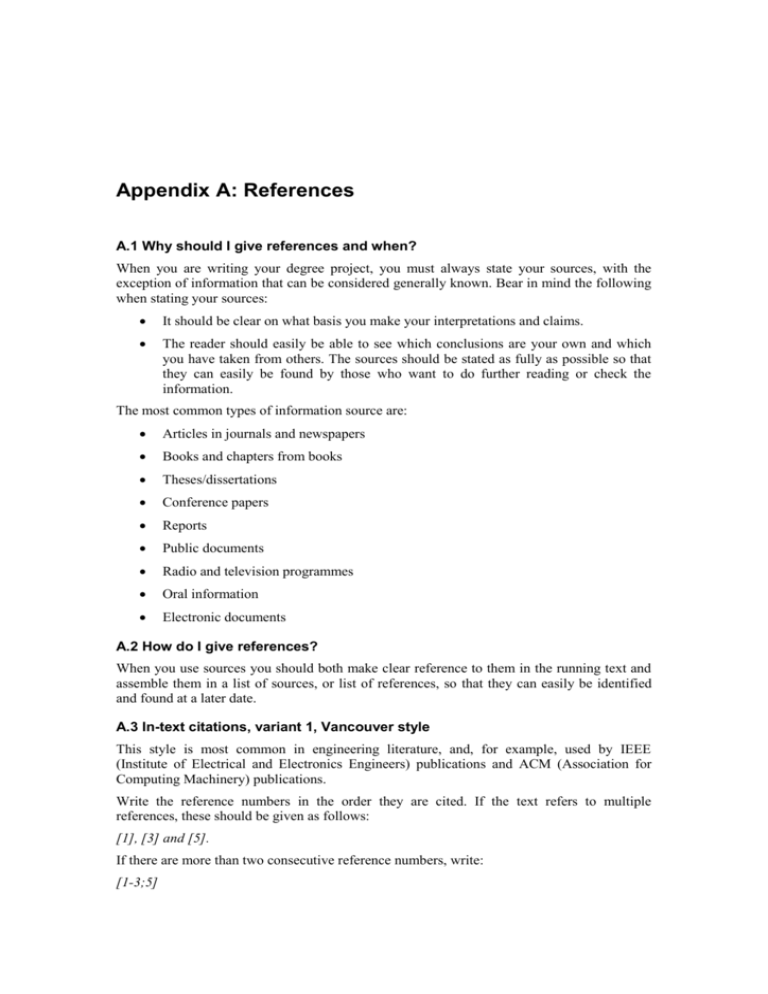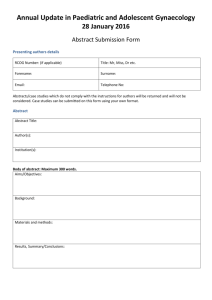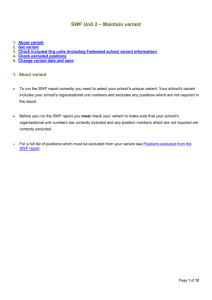References
advertisement

Appendix A: References A.1 Why should I give references and when? When you are writing your degree project, you must always state your sources, with the exception of information that can be considered generally known. Bear in mind the following when stating your sources: It should be clear on what basis you make your interpretations and claims. The reader should easily be able to see which conclusions are your own and which you have taken from others. The sources should be stated as fully as possible so that they can easily be found by those who want to do further reading or check the information. The most common types of information source are: Articles in journals and newspapers Books and chapters from books Theses/dissertations Conference papers Reports Public documents Radio and television programmes Oral information Electronic documents A.2 How do I give references? When you use sources you should both make clear reference to them in the running text and assemble them in a list of sources, or list of references, so that they can easily be identified and found at a later date. A.3 In-text citations, variant 1, Vancouver style This style is most common in engineering literature, and, for example, used by IEEE (Institute of Electrical and Electronics Engineers) publications and ACM (Association for Computing Machinery) publications. Write the reference numbers in the order they are cited. If the text refers to multiple references, these should be given as follows: [1], [3] and [5]. If there are more than two consecutive reference numbers, write: [1-3;5] Sometimes, you want to be more specific, and give a page number: [1, p. 45]; [1, pp. 45, 52]; [1, pp. 44–48] If the final page is not easily determined, write [1, pp. 45ff.]. Note that the symbol ‘pp.’ is used when referring to multiple pages. With other information: [3, theorem 1]; [3, heading 4.5]; [3, lemma 2]; [3, equation (2)]; [3, figure 1]; [3, chapter 2, pp. 5–10]; [3, appendix I]; [3, algorithm 5]. Avoid splitting a citation reference at the end of a line. Where necessary, use a non-breaking hyphen, CTRL+SHIFT+- (hyphen), or a non-breaking space, CTRL+SHIFT+space. A.4 In-text citations, variant 2, Harvard style There are several different ways of referencing, but choose variant 1 or this variant, Harvard style. The Harvard style is used most commonly in humanities. It is also somewhat clearer in text, as you always name you references where they are referenced. An example: .. is surrounded by a grove of rich variation including psychology, computer science, pedagogy, social sciences and design science (Dix, Finlay, Abowd, & Beale, 1993; Gulliksen & Göransson, 2002; Sharp, Rogers, & Preece, 2002)… As you see, the references are written in regular parentheses (), and the surnames of the authors are given, as well as the publication year. Different references are separated with “;” and authors with “,” and “&”. There are some special rules to this: If the authors are more than 4, give the first author and add “et al.” (short for “et alia” in Latin meaning “with others”) to it: (Wood et al., 2003) If you have more than one publication with the same set of authors the same year, the publications are referred to as “a”, “b” etc: (Rassmus-Gröhn, Magnusson, & Eftring, 2007b) If you are mentioning the names of the authors more explicitly in text, you do this without the parentheses around the name(s), and only put the publication year in parenthesis: “The importance of information transfer between users and developers has been described by von Hippel (2005), who characterizes information as being “sticky”…” Note that the references should be in non-italic text, the italics above are used only to clarify that they are examples. A.5 Reference examples by type in the references chapter This section contains examples of references, grouped into different categories. Note that the references in the report shall not be regrouped by type. In the case you use variant 1 (Vancouver) they should be put in the order of their appearance in the body of the report. In the case of variant 2 (Harvard), they should be put in alphabetical order according to the first authors surname. Articles in journals and newspapers Written in the order author, year, title, journal/newspaper, issue, page(s): [1] Gustafsson, H., Eklund, G., & Törnvall, A-M. (2003). Effects of wood ash application to forests. Journal of the Environment 23, 214–221 Books Written in the order author, year, title, publisher, place of publication, country: [2] Booth, W. C., Colomb, G. G. & Williams J. M. (1995). The craft of research. University of Chicago Press, Chicago, USA Book chapters Written in the order author, year, title of chapter, editor(s), book title, publisher, place of publication, country, page number(s): [3] Guba, E. G. & Lincoln, Y. S. (1994). Competing paradigms in qualitative research. In: Denzin N. K. & Lincoln Y. S. (eds.) Handbook of Qualitative Research. Lewis Publishers, Toronto, Canada, pp. 71–80 Theses Written in the order author, year, title, type of thesis/dissertation, department/division, university, place: [4] Svanberg, J. (2006). A constructive approach to the interaction between risk and logistics – a study of total offers in the aerospace industry. Doctoral thesis. Division of Packaging Logistics, Lund University, Lund Conference papers Written in the order author, year, title, name of conference, date, place, country, page(s): [5] Kjeldsen, P. & Hansen, T. (1993). Manufacturing models – a comparative study. Proceedings of the 2nd International Conference on Model Assessments, 22–24 May, Tübingen, Germany, pp. 134–139 Reports Written in the order author, year, title, organisation, place: [6] Johansson, T. (2001). Utvärdering av simuleringsmodeller. Internrapport PA:243, Department of Technology Management, Chalmers University of Technology, Gothenburg Public documents Written in the order title, year, place of publication, author, series: [7] Att fånga kunnandet om lärande och undervisning (2005). Stockholm, Ekholm, M., Ds departementsserien 2005:16 Oral information Interviews, telephone conversations, letters, emails and lectures are given in the list of references. [8] Carlqvist, Ola, lecturer at Division of Machine Design, Lund University, personal conversation 11 March 2007 Electronic information There is no difference in how you should describe this type of document compared with an equivalent printed document. However, immediately after the title you should write ‘Electronic’ in brackets. At the end of the reference you should state where the document can be found – often you can give the document’s URL. You should also give the date when you accessed the electronic document, because the URL could change. Note that an email is considered oral information. [9] Breidegard, B. (2006). Att göra för att förstå – konstruktion för rehabilitering (Electronic). Doctoral thesis, Division of Rehabilitation Engineering Research, Faculty of Engineering, Lund. http://www.certec.lth.se/dok/attgora/AttGoraForAttForsta_Light.pdf, 2007-09-04 [10] Industriell robotteknik (Electronic). http://www.mkon.lth.se/forskning/robotteknik/industriell_robotteknik, 2007-06-11











